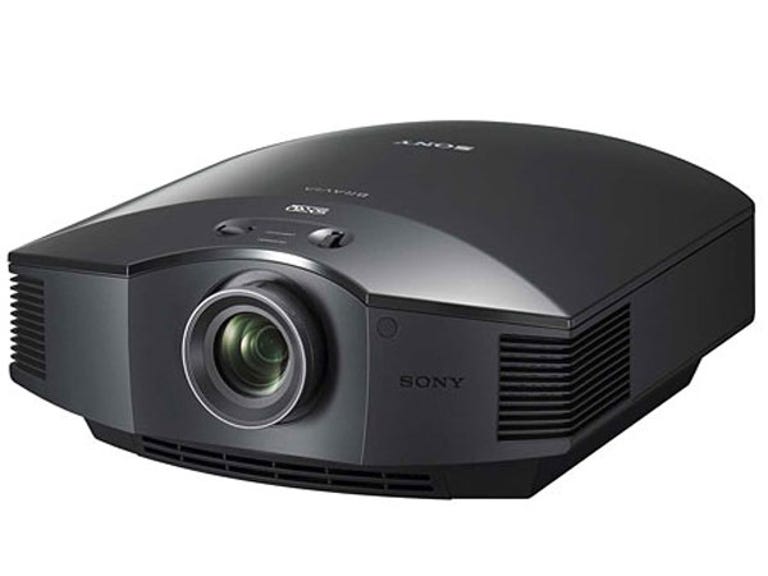 Why You Can Trust CNET
Why You Can Trust CNET Sony VPLHW15 review: Sony VPLHW15
The Sony VPLHW15 may cost you more than a budget 1080p, but the images it presents make it well worth the money.
With Full-HD 1080p projection now available for under AU$2000, what do get if you spend more money? Well, there’s a basic consumer electronics' rule of diminishing returns which says to get a marked improvement you need to spend about twice as much. So, does this apply to Sony's new VPLHW15 which has an RRP of nearly AU$4500 but can be had with a bit of shopping around for AU$3500?
The Good
The Bad
The Bottom Line
Design and features
Like a lot of 1080p projectors, the VPLHW15’s a physically substantial piece of kit. Beneath its shiny black exterior it uses Sony’s proprietary SXRD chipset in a triple panel array (as opposed to conventional LCD and DLP chipsets). Coupled to this we have a 200-Watt ultra-high pressure lamp rated at 1000 Lumens and an improved Dynamic Iris that is said to produce a contrast ratio of a whopping 60,000:1. Sony’s Bravia Engine 2 also works its digital video processing magic, by aiming to reduce picture noise and enhance detail as well as being compatible with both Deep Color and x.v.Color technologies.
Two HDMI 1.3a inputs are provided along with RCA and 15-pin component ins, plus S-Video and composite video connections as well. External automated control is via the standard RS-232 port and the VPLHW15 also includes Sony’s Bravia Theatre Sync to communicate with other compatible Sony gear, say an AV receiver or Blu-ray player.
It comes with a decent-sized backlit remote, which not only gives you direct access to the main projector settings, such as Black Level, Advanced Iris and Colour Processing, there are also some playing and chapter controls for aforementioned Bravia Theatre Sync players. Delving into the Sony’s menu reveals a substantial amount of set-up options, but thankfully the interface is well laid out and intuitive to follow. We’d once again advise a proper calibration to get the very best possible picture quality — either with the help of a do-it-yourself DVD or BD or better still a professional job that will set you back around AU$300.
We made a few setting adjustments and liked what we saw in "Cinema" mode with the Dynamic Iris on and we also left the colour temperature at the default "Low" setting; all of which produced more than enough brightness in our darkened AV room. Table-top mounted, the Sony needed a little keystone correction as well, but thankfully the image edge remained tight and true.
Performance
Once calibrated, this projector produced some of the best blacks we’ve seen from any projector and that super high contrast level isn’t a figment of Sony engineers’ imagination either. Bright against dark images looked superbly clear-cut — we found ourselves completely lost in the BD of Kubrick’s masterpiece 2001: A Space Odyssey. We only wanted to watch a few key scenes but ended up watching all 148 minutes, even though we’d seen the film countless times before. The Sony made it an almost new experience with its ability to retrieve the finest detail and presented the 41-year-old film in an almost completely fresh light. It handled the film’s rich, dark shades and shadow graduation superbly — be it deep space scenes or aboard the Discovery 1 en route to Jupiter, the Sony consistently produced images of outstanding quality.
Playing something a little more modern, Transporter 3 also had us hooked and drawn into the action. Here, the Sony’s colour balance and skin tone handling abilities were clearly impressive. These two qualities looked effortlessly natural and well balanced. Colour saturation was superb with an even, warm texture but still retaining good edge definition. We were surprised to find that even close up to the screen, the pixel structure was almost invisible — the SRXD chipset can be thanked for this; helping the VPLHX15 to reproduce these smooth and very cinematic looking images.
With HD content, the Sony will impress, no matter the sort of material — it looked great with Blu-ray, Foxtel HD or One HD sports broadcasts. We also tried it with a couple of SD sources — for gaming, we hooked it up with a Nintendo Wii; and with upscaled DVDs from a decent Onkyo DVD player. The same qualities that make this projector stand out with HD material also have the same effect with SD images — there’s that same depth to blacks, superb contrast and natural colour balance while detail levels and brightness remained high, admittedly not to the same degree as 1080p content. We had times when some ambient light was seeping into the room but it didn’t present the Sony a problem. The amount of operational noise doesn’t alter too much either with the fan barely audible even on the brightest setting.
Running costs come into the equation here and although Sony doesn’t put an actual figure on the lamp’s operational hours, it has been reported elsewhere at 2000. You’d hope this would be extended with lower brightness use but at around AU$500 a pop, the Sony’s going to cost a bit more to run than some other 1080p projectors. You may need to factor in that it’s also going to initially cost a bit more due to a higher sticker, but that’ll probably fade into a distant memory once you clap eyes on its image quality.
Conclusion
Spending more bucks can well be worth it and this Sony is one such projector than equates more outlay into higher quality HD pictures. Its size and slightly limited lens shifting makes it less flexible with placement than some, but if you’ve the room it’ll fill a screen (up to 300 inches), very nicely.
